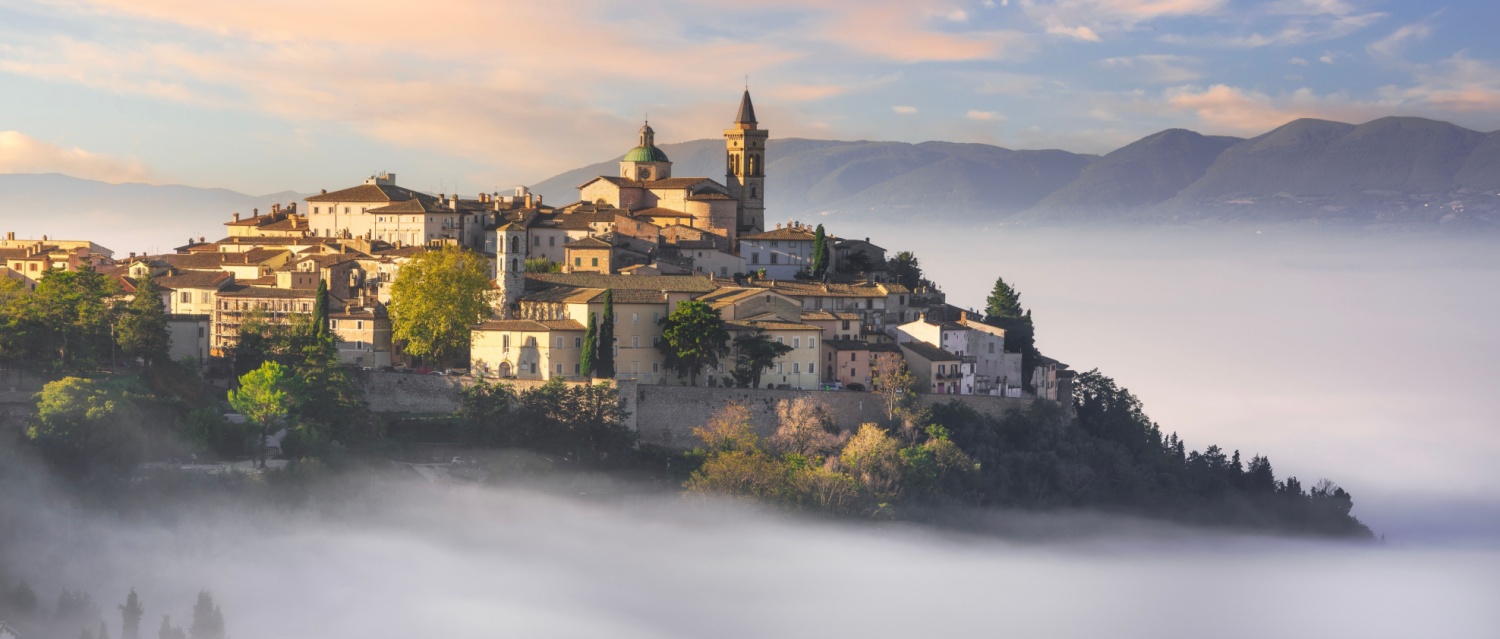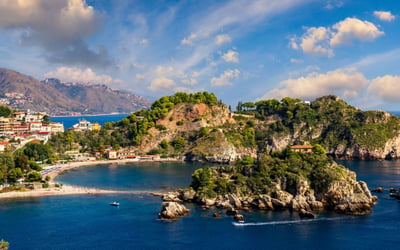Welcome to Umbria – “The Green Heart of Italy”. Bordered by Tuscany, Lazio and Le Marche, and framed by the Apennines, it’s the only Italian region without a coastline or foreign border.
Expect rolling hills lined with cypress trees, olive groves and vineyards, crystal-clear lakes, forests and medieval hill towns. If you love Tuscany’s scenery but want more space for your budget, Umbria delivers the same romance with an authentic, less touristed feel.
Contents
- Why you should be buying property in Umbria
- Umbria’s property market at a glance
- Where to buy property in Umbria
- Getting there and connectivity
- Is buying a property in Umbria a good investment?
- The buying process in Umbria
- How much it costs to buy in Umbria
- Frequently asked questions
Why you should be buying property in Umbria
Authentic Italy (without the crowds)
Umbria’s towns and villages feel wonderfully genuine: weekly markets, artisans, seasonal food and local festivals (Sagre). From Assisi to Spello, Perugia to Gubbio, it’s rich in art, spirituality and everyday Italian life.
Tuscany’s look — Umbrian value
You’ll find the same rolling countryside, cypress-lined lanes, vineyards and stone farmhouses as across the Tuscan border — at notably lower prices. Many buyers who are priced out of Florence or Siena discover they can afford larger, characterful homes in Umbria.
Scenery, food and wine
Hike Monte Subasio from Assisi to Spello, ride the tiny cable car in Gubbio for Apennine views, and visit Marmore Falls — among the world’s tallest man-made waterfalls. Culinary highlights include truffles, pecorino, prosciutto di Norcia, and revered wines from Orvieto (whites) to Torgiano and Montefalco (reds).
Festivals and culture
Perugia’s Eurochocolate (October) and Umbria Jazz (July, plus winter editions) bring global audiences; Gubbio’s Ceri Festival (15 May) and Spoleto’s Festival dei Due Mondi (June–July) fill towns with music and performance — great for lifestyle and potential rentals.
Umbria’s property market at a glance
Umbria comprises just two provinces — Perugia and Terni — and a landscape of medieval towns, lakes (Trasimeno), rivers and mountains. You’ll see everything from frescoed townhouses and apartments in historic centres to stone farmhouses (casali) with land.
- Price context: Average prices in Umbria are generally less than half those in Tuscany overall. Indicatively (historic figures), Perugia municipality has averaged around €1,100–€1,200/m², with regional averages slightly lower; Tuscany’s regional average is much higher, skewed by Florence/Siena.
- Entry points: Remote villages sometimes list small homes under €100,000, and renovation projects can fall below €50,000. Character farmhouses with outbuildings typically start around €150,000, depending on condition and access.
- Where it’s best value: Southern/central areas such as Terni, Narni, Amelia, Spoleto and Norcia often have lower pricing and more renovation stock.
- Lifestyle stock: Around Lake Trasimeno you’ll also find subdivided estates with shared pools/gardens — ideal lock-up-and-leave holiday homes.
Where to buy property in Umbria
Many buyers prefer to be within ~45 minutes of Umbria International Airport (between Perugia and Assisi). Below are evergreen favourites that blend lifestyle, access and value:
Perugia
Capital of the region and a lively university city (two historic universities). Historic centre highlights: Piazza IV Novembre with the Maggiore Fountain, Palazzo dei Priori and the Cathedral of San Lorenzo; Rocca Paolina’s underground passages. The city hosts Eurochocolate and Umbria Jazz, and provides big-city services even if you base yourself in a nearby village. Expect apartments in palazzi and converted country houses with shared amenities.
Assisi & Spello
Both under 20 minutes from the airport. Assisi (UNESCO) blends art and spirituality; Spello (one of “I Borghi più belli d’Italia”) charms with Roman gates, mosaic floors and winding stone lanes. The Assisi–Spello hike over Monte Subasio serves jaw-dropping views — a perfect weekend ritual.
Gubbio
Historic, atmospheric and just ~35 minutes from the airport by the quickest of three scenic routes (also ~1 hour from Ancona and the sea). Ride the tiny open cable car for views; explore the Roman theatre (c. 20 BC) and the layered Gothic-Renaissance centre. Popular for year-round living thanks to full services (~33,000 residents).
Lake Trasimeno & Castiglione del Lago
~25–45 minutes from the airport. Trasimeno is central Italy’s largest lake — kayaking, sailing, cycling, swimming and island ferries to Maggiore/Polvese. Towns include Castiglione del Lago (also listed among Italy’s most beautiful villages), Panicale, Città della Pieve, Passignano and Monte del Lago. Expect classic stone houses and farmhouses; some subdivided with shared pools — perfect for holidays and rentals.
Spoleto
~40 minutes from the airport on good roads. Rich in art and architecture — cathedral, Albornoz fortress, Roman aqueduct/theatre — and home to the Festival dei Due Mondi. Old-town escalators make hill walking easier; surrounding valleys and oak forests offer great hiking. Suits buyers seeking space/privacy with a cultural town close by.
Getting there and connectivity
By air
Umbria International Airport (Perugia “San Francesco d’Assisi”) sits between Perugia and Assisi, with routes to major European cities (some seasonal). From the UK, typical carriers include Ryanair (Stansted) and BA (Heathrow). The airport links easily to Siena, Ancona, Assisi and Rome via major roads.
By rail
Orvieto (south-west Umbria) lies on the Florence–Rome line, putting Rome’s Termini and FCO airport within easy reach; Perugia and Foligno connect across the region. Expect convenient regional services and scenic branch lines.
By road
Perugia ↔ Siena ~1h20; Orvieto/Terni ↔ Rome often <1h30 (traffic dependent). Good motorway and superstrada access makes multi-stop trips (Tuscany, Lazio, Marche) straightforward.
Is buying a property in Umbria a good investment?
Umbria has shown steady price growth while remaining more affordable than Tuscany — a compelling combination for lifestyle buyers. Tourism is rising (notably strong festival calendars), supporting seasonal rental demand around Perugia, Assisi/Spello, Spoleto and Lake Trasimeno. A lower cost of living helps retirees and relocators.
As with any market, values can fluctuate. Assess micro-locations, condition/renovation budgets and access. For older stone homes, budget for structural/survey checks; in higher-risk seismic zones (south-east mountains) plan for modern reinforcements as required by code and ask your geometra about available incentives.
The buying process in Umbria
Foreigners can legally buy in Umbria. With the right team, it’s straightforward:
- Define your brief: Property type, size, location radius (e.g., within 45 minutes of the airport), budget and must-haves.
- Research & shortlist: Compare Perugia, Assisi/Spello, Gubbio, Trasimeno and Spoleto. Visit to test travel times and amenities.
- Engage professionals: Independent lawyer (avvocato), notary (notaio), reputable estate agent; consider a currency specialist to manage exchange-rate risk.
- Viewing trip: Line up multiple homes (including renovation vs. turnkey). Take photos/notes for like-for-like comparison.
- Offer: Submit via your agent. Once accepted, due diligence begins.
- Preliminary contract: Sign the contratto preliminare/compromesso and pay the caparra (often ~10%).
- Financing & tax code: Obtain codice fiscale; arrange mortgage or proof of funds.
- Completion: Sign the rogito before the notary; pay balance and fees.
- Registration & utilities: The notary/lawyer registers the deed. Set up utilities/insurance and any works.
- Move in: Furnish and enjoy — or prepare the property for holiday letting if that’s part of your plan.
How much it costs to buy in Umbria
As a rule of thumb, budget an extra ~10–15% of the purchase price for fees and taxes:
- Purchase taxes: Main residence usually 2% of cadastral value; second homes ~9%. New-builds: VAT at 4%/10%/22% depending on use/spec.
- Notary & legal: Often 2–4% combined (transaction-dependent).
- Agent commission: Typically 3–5% (confirm split).
- Other one-offs: Surveys/technical checks (especially for older stone homes), connections, and currency transfer costs.
- Ongoing: IMU (for second homes), TARI waste tax, utilities/maintenance and any community fees
Frequently asked questions
Is Umbria cheaper than Tuscany?
Generally yes. Average prices are markedly lower, especially outside the biggest centres — one reason many Tuscany-lovers buy across the border in Umbria.
Where can I find the best value?
Southern/central areas (Terni, Narni, Amelia, Spoleto, Norcia) and more remote villages. Renovation projects can start under €50,000.
What areas are easiest from the airport?
Within ~45 minutes: Perugia, Assisi, Spello, Gubbio, Lake Trasimeno (Castiglione del Lago, Passignano, Monte del Lago), Todi and Spoleto (~40 mins on good roads).
Is Umbria good for rentals?
Yes — festival-driven demand (Umbria Jazz, Eurochocolate, Spoleto) and lakeside/cultural hotspots can generate strong seasonal bookings.
Are earthquakes a concern?
Risk is higher towards the south-east mountains; lower in the west (Amelia/Orvieto/Narni). For older homes, get a seismic vulnerability assessment and plan compliant reinforcements where needed.



